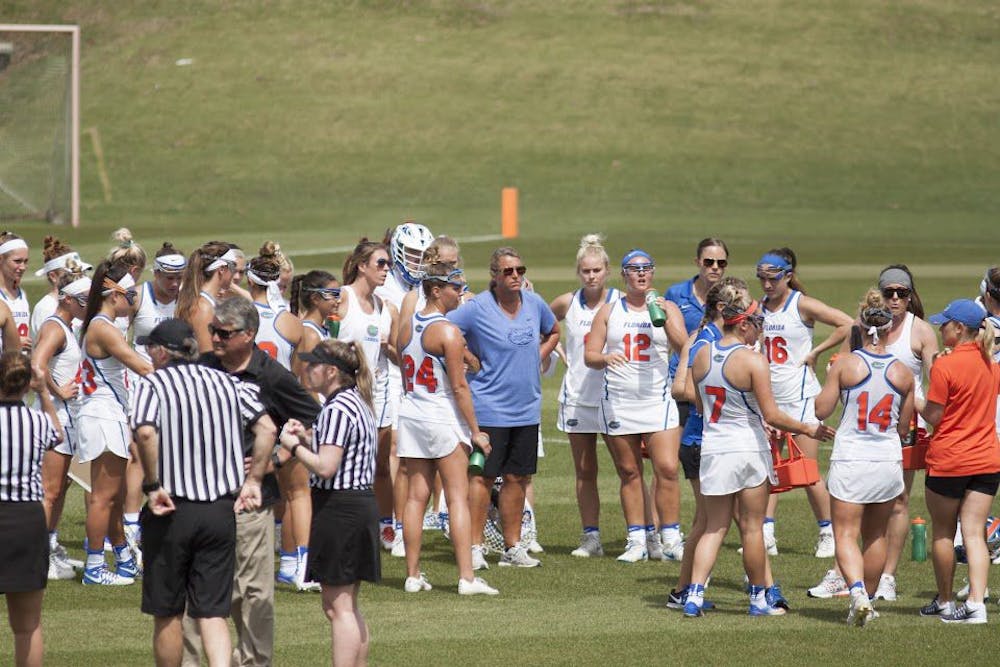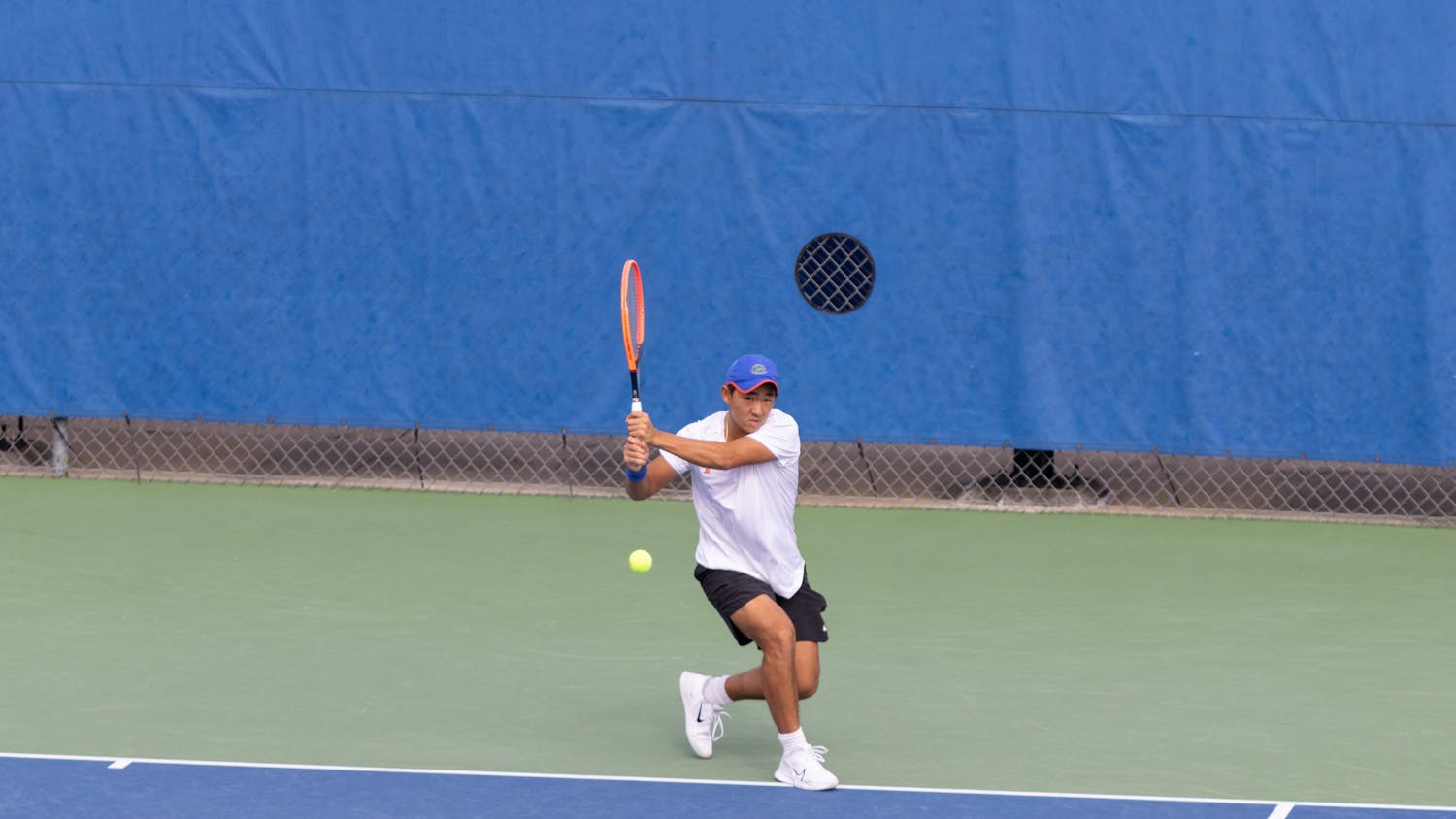The Florida lacrosse team wasn’t supposed to make it this far.
For a program in its third season, a 19-3 record was impressive. A win over No. 1 Northwestern for its first American Lacrosse Conference Championship was impressive. An NCAA Tournament first-round win over Albany was impressive.
But then UF faced Penn State in the quarterfinals.
Never before had a team won two games in the NCAA tournament within its first three seasons. A 15-2 win over the Nittany Lions, however, changed that.
“I think it took a lot of people by surprise,” coach Amanda O’Leary said. “There was a little bit of a surprise that we were able to get to the Final Four in our third season.”
To those outside the program, the Gators’ convincing win over Penn State was a surprise because of how young the program was. Other new lacrosse programs didn’t see nearly the same level of success.
But to O’Leary and those within the program, UF’s win was expected. O’Leary, nicknamed Mandee by her players, had been training the Gators for the last three years and knew better than anyone what her team was capable of.
“That season was a real testament to the hard work and effort those girls put in to lead up to that,” O’Leary said.
After Florida’s Final Four run, the team emerged onto the national scene, where it has remained ever since.
It's a team O'Leary has built up from nothing to become one of the nation's most dominant. But despite how much the Gators have been tested and how much success they have had in conference play, there's still something missing.
• • •
Former Gators athletic director Jeremy Foley made Amanda O’Leary a promise when she was hired as the first head coach of the Florida lacrosse team.
“We’re not going to build you the Taj Mahal of facilities,” Foley told her, “but it’s going to come pretty close.”
While O’Leary was out on the recruiting trail preparing a team for the Gators’ inaugural season in 2010, Foley was busy getting Florida’s lacrosse facility up and operational. By the time the Gators were ready to play Jacksonville on Feb. 20, Donald R. Dizney Stadium was ready.
“I think this is the Taj Mahal of lacrosse facilities,” O’Leary said.
The grounds were equipped with a 12,000 square-foot athletic facility, which included locker rooms, a training room, an equipment room, a conference room and two lacrosse fields — one for games and another for practice.
Once it was ready, O’Leary needed to prepare her team.
Before coming to Florida, O’Leary was the head coach of Yale, where she coached for 14 seasons. But upon completing her final year with the Bulldogs, she heard about a new opportunity.
The University of Florida was starting a lacrosse program, and it was looking for a coach to spearhead the creation of a team that could compete on a national level.
“I think it’s one of those dream jobs,” O’Leary said. “They don’t come along very often, and I thought to be able to compete at the highest level at an institution that supports athletics at such a high level, it was a no-brainer.”
O’Leary submitted her application and received a call from the school for an interview.
In June 2007, O’Leary was contacted again by UF.
She had the job.
She accepted immediately.
“The ability to come in here and have the opportunity to start a program but also start a program at a university that was competing at such a high level across the board at all sports,” O’Leary said, “that was pretty exciting.”
Her biggest challenge was finding players who bought into what the Gators and O’Leary were selling.
“We didn’t have anything to show,” O’Leary said.
Florida did have a lot to offer, however.
It offered the chance for recruits to be a part of a new program that O’Leary and Foley’s administration had extremely high hopes for. A team that, on paper, could become one of the top programs in the nation.
The 29 players Florida had at the start of 2010 saw that opportunity and took it. The 24 freshmen on the roster saw the success of UF’s other women’s teams, and they bought into the dream.
“They were all in,” O’Leary said.
And they showed promise early on.
The Gators went 10-8 in their first season, taking down ranked teams like Johns Hopkins and Penn State.
Then they ran into defending national champion No. 2 Northwestern, a team that reigned over the American Lacrosse Conference in the years before Florida came around.
It was O’Leary’s first major test as the coach of the new program.
“I don’t know if we even got the ball over the 50-yard line but a couple times,” O’Leary said.
The Gators were down 14-0 at halftime. Northwestern trounced Florida 19-5 that game. But O’Leary was optimistic, using that game as motivation for where she wanted to see the team eventually rise to.
“That was the level we wanted to be able to play at in the future," she said.
And that future was closer than she thought.
• • •
In 2014 the ALC was disbanding, and that year’s conference tournament was the last.
From 2011 to 2014, Florida made every championship game. Its opponent in each game never changed: Northwestern.
But Florida had only won one conference tournament title since its creation.
And now, in the ALC’s last tournament, the championship came down to one last battle between the conference’s two best teams.
The game was decided by one goal, a shot by UF's Mollie Stevens from eight meters out. Florida battled back from a 7-2 halftime deficit to secure a 9-8 victory and earn Florida’s second tournament title.
Northwestern was leaving for the Big Ten, as was Penn State and Ohio State. Johns Hopkins went independent for a year but ultimately went to the Big Ten the next season.
That left Florida and Vanderbilt as the only two teams left.
“We wanted to join a conference. We didn’t want to go independent,” O’Leary said. “I thought it was important for us to be a part of a conference.”
O’Leary believed that in order for the Gators to succeed on the national level, being part of a conference rather than being independent would go a long way come time for the NCAA Tournament.
The ALC disbanded after the conference championship game in May. The following month, Florida announced it would join the Big East conference starting in 2015.
When it came time to change conferences, O’Leary said the team was looking forward to continuing the success it had over its first five seasons in the ALC.
Since joining the Big East, the Gators have been the team to beat. Florida has lost just one conference game since making the move and has won both the regular season and tournament titles every year.
The impact of the move, however, meant O’Leary had to push a tougher nonconference schedule.
The 2017 season alone featured Florida playing the preseason No. 1, No. 2, No. 4, No. 5 and No. 6 teams.
But for O’Leary, this isn’t an issue, and as for playing in the Big East, she is pleased with how things turned out.
Since 2015, the Gators have boasted two Big East regular-season titles, two Big East tournament titles and a 20-1 conference record.
“I would say it’s worked out,” O’Leary said.
• • •
Caroline Fitzgerald was playing in a tournament in New Jersey for the Long Island Yellow Jackets when her coach, Carol Rose, got a text.
There was a lot of excitement buzzing around the UF lacrosse team following its first Final Four appearance, and the Gators was interested in having Fitzgerald play for them.
“I was really excited when I first heard that Florida was interested in having me come here,” Fitzgerald said. “Just seeing what their sports programs altogether have accomplished, and then seeing how quickly their lacrosse program rose to being a top program was really exciting and drew me in."
The Mount Sinai, New York, native was drawn in by the same ideas presented to Florida’s first class: the coaches’ commitment to building the best team possible and the emphasis on academics and athletics.
Fitzgerald’s recruiting class served as yet another test for O’Leary. Now that Florida was established, how well could it recruit to remain that way?
O’Leary answered back with a signing class of 11 players, which included four future team captains: Fitzgerald, Stevens, Taylor Bresnahan and Sammi Burgess. Burgess and Stevens have over 100 career goals each, and Fitzgerald and Bresnahan are UF's all-time leaders in caused turnovers.
It’s a testament to how well O’Leary can not only build a program, but also maintain one.
O’Leary showed, just like with that first team in 2010, that her freshmen can make an impact right away.
“They definitely paved the way for us, and they left that legacy behind and what we wanted to do was keep it going,” Fitzgerald said. “Every year, we work towards getting better. The ultimate goal is to win a national championship.”
Seven years after Florida’s inaugural season, the Gators still have that goal in mind: a national championship.
For a program as dominant as Florida's, that first national championship has eluded it.
It’s the house O’Leary built, and the only addition left is a title.
Follow Jake on Twitter at @DreilingerJake, or contact him at jdreilinger@alligator.org.
UF lacrosse head coach Amanda O'Leary stands in the center of her players during Florida's 15-8 win against Denver on March 25, 2017, at Donald R. Dizney Stadium.






